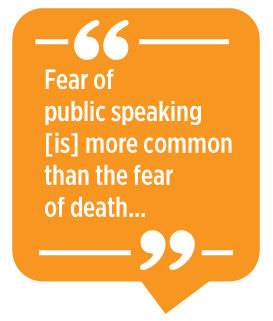Creative Activities for Improving Students' Public Speaking Skills
by Lisa Leopold

A large-scale survey among U.S. college students, which
replicated earlier studies among the general population, found that fear of
public speaking was more common than the fear of death (Dwyer &
Davidson, 2012). Those survey results are reflective of speeches delivered in
one’s first language, so imagine the fear nonnative-English-speaking students
must experience when delivering a speech in their second, third, or fourth
language. In fact, research shows that public speaking is extremely challenging
for nonnative English speakers (Barrett & Liu, 2016), yet it is also
essential for their success (Zhang & Ardasheva, 2019). Despite the
importance of public speaking, most English for academic purposes (EAP)
programs prioritize academic literacy over oratory skills (Bankowski, 2010).
However, training in public speaking can yield enormous benefits. Not only does
it improve students’ oral English skills, but it also develops students’
critical thinking and enhances their intercultural communication skills (Lucas,
2013).
The
following activities are intended to hone students’ verbal and nonverbal
delivery skills for presentations. The activities were incorporated into a
Professional Presentation Skills course for international graduate students at
an advanced proficiency level, though they could easily be adapted for any
intermediate or advanced EAP or English as a second language course in which
students deliver presentations.
Improving Verbal Delivery Skills
Reducing
Fillers
Excessive
fillers (such as “um” or “ah”) may reduce a speaker’s credibility and distract
the audience from the presenter’s main message. By drawing students’ conscious
attention to their use of fillers, these activities are intended to reduce
their frequency.
 Game 1
Game 1
In the first
game, one student speaks in front of the class (about a topic of his or her
choice or a given topic) for 1 minute. Every time the student uses a filler,
the class claps their hands, and one student in the audience counts the total
number of fillers the speaker used. The cycle is repeated until all students
have delivered a 1-minute speech. The student who has used the fewest number of
fillers wins the game.
Game 2
In the
second game, the class is divided into two teams seated on opposite sides of
the classroom. One student from each team stands in front of the opposing team
to speak (simultaneously) about a topic the opposing team selects. As soon as either
speaker uses a filler word, that student is “out,” and the other team wins a
point. The game continues until all students have spoken, and the team with the
highest score wins the game.
Improving Voice
Projection
A powerful
voice commands attention and is particularly important when speaking to a large
audience. This activity is intended to help students project their voices when
speaking in a large auditorium and is best conducted in a spacious venue or
outside.
Students
form two lines facing each other (no more than 12 inches apart). With the
person directly across from them, students carry on a conversation about any
topic (e.g., their coursework, their weekend plans), as they continue to step
farther apart from their classmate. They must project their voices loudly to be
heard by their partner over the other voices in the room.
Improving Intonation,
Pausing, and Stress
How a speech
is delivered—in a monotone or passionate way—may have a lasting impact on the
audience’s retention of information. This activity is intended to help students
improve intonation, pausing, and stress in presentations.
Part 1: Analyzing the
Speech
As students
follow along with a transcript, they watch short recorded versions of two
speakers: one monotone and the other passionate. For the monotone speech, I
have used 11:03–11:31 of Steve Jobs’ 2005 commencement
address at Stanford University. For the passionate speech, I have
used 27:47–28:05 of Cory Booker’s 2017 commencement
address at the University of Pennsylvania. Students mark their
transcripts for the intonation, pausing, and primary and contrasting stress
they hear the speaker use. It is helpful to divide the class so that 1/3 of the
students are focused on intonation, 1/3 on pausing, and 1/3 on stress. It is
also helpful to allow them to listen to the speeches multiple times. The class
debriefs afterwards on the lessons learned (e.g., where stress commonly falls,
such as on contrasting words or on the last content word in a message unit, or
where in a speaker’s delivery he typically pauses, such as at the end of a
message unit).
Part 2: Delivering the
Speech
All students
in the class then receive excerpts from two different speech transcripts, which
should be less than 1 minute when delivered orally. One speech excerpt is for
themselves; the other is for their partner. No student pair should be assigned
the same speech excerpts as another pair.
Working individually,
each student marks the two transcripts for places to pause, words to stress,
and how to use intonation. Working in dyads, each student reads aloud one of
the passages as the partner follows along with the transcript they have marked.
The listener provides suggestions for improving vocal variety, such as, “Try
stressing this word, or try pausing longer after this phrase.” After all
students have practiced honing their delivery skills with the help of their
peer coach, they sit in the front of the classroom with their backs facing the
projector screen behind them. One student stands up, facing the audience and
the projector screen and delivers their passage aloud to the others. They use
the words projected on the screen in front of them (which the instructor has
prepared on a slide deck) as a teleprompter for their script. After all
students have delivered their passages, they vote for the “best” delivery
(other than their own), and the student earning the most votes is awarded a
prize.

Improving Nonverbal Delivery Skills
Improving Eye
Contact
Many
presenters have the tendency to divert their eyes up or down, away from the
audience, when thinking of what to say next. This activity is intended to help
presenters sustain continuous eye contact.
Working with
a partner, one student speaks for 1.5 minutes about a topic chosen by their
partner. The partner claps their hands anytime the speaker breaks eye contact
by looking up, down, or away. Then, students switch roles as the presenter and
audience member. When they have mastered sustaining eye contact for 1.5
minutes, the length of time can be gradually increased.
Improving Hand
Gestures
Many
presenters gesture spontaneously, without careful planning, which sometimes
results in repetitive, nonpurposeful hand movements. This activity is intended
to help students use meaningful hand gestures.
Standing in
a circle, students take turns demonstrating how they would gesture for various
speaking purposes, to
-
emphasize a
point,
-
show contrast between
ideas,
-
indicate a division of
points into categories,
-
enumerate points,
-
show receptiveness to the
audience, and
-
encourage the audience to
participate.
Students
discuss cultural variations and taboo gestures (e.g., with which finger they
start counting or whether it is considered impolite to point to the
audience).
As a
variation of this activity, students play “gesturing charades,” whereby one
student draws a card with an instruction, such as “enumerate points.” The
student uses a nonverbal hand gesture to convey this meaning, and the class
guesses the meaning the student is trying to convey.
Conclusion
The
aforementioned activities are intended to help students polish their
presentation skills. As an added benefit, the activities build camaraderie and
trust, thereby mitigating students’ fears of public speaking.
Note: A version of this
article first appeared in the December 2021 issue of As
We Speak, the newsletter for the TESOL International
Association Speech, Pronunciation, and Listening Interest
Section.
References
Bankowski,
E. (2010). Developing skills for effective academic presentations in EAP. International Journal of Teaching and Learning in Higher Education, 22(2),
187–196.
Barrett, N.
E., & Liu, G. (2016). Global trends and research aims for English
academic oral presentations: Changes, challenges, and opportunities for
learning technology. Review of Educational Research,
86(4), 1227–1271. https://doi.org/10.3102/0034654316628296
Dwyer, K.
K., & Davidson, M. M. (2012). Is public speaking really more feared
than death? Communication Research Reports, 29(2), 99–107.http://dx.doi.org/10.1080/08824096.2012.667772
Lucas, S. E.
(2013). English public speaking and the cultivation of talents for Chinese
college students. Chinese Journal of Applied Linguistics,
36(2), 163–182. https://doi.org/10.1515/cjal-2013-0011
Zhang, X., & Ardasheva, Y.
(2019). Sources of college EFL learners’ self-efficacy in the English public
speaking domain. English for Specific Purposes, 53, 47–59. https://doi.org/10.1016/j.esp.2018.09.004
Lisa
Leopold specializes in teaching English for
academic and professional purposes to international graduate students. Her
research interests include pragmatics and public speaking
pedagogy.